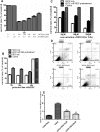Resveratrol protects human lens epithelial cells against H2O2-induced oxidative stress by increasing catalase, SOD-1, and HO-1 expression
- PMID: 20806083
- PMCID: PMC2925910
Resveratrol protects human lens epithelial cells against H2O2-induced oxidative stress by increasing catalase, SOD-1, and HO-1 expression
Abstract
Purpose: Oxidative damage induced by H(2)O(2) treatment can irreversibly damage the lens epithelium, resulting in cell death and cataract. Whether the effects of oxidative stress could be attenuated in cultured human lens epithelial cells by incubation with resveratrol (RES) is still unknown. In the present study, we examined the function of resveratrol in protecting human lens epithelial B-3 (HLEB-3) cells against H(2)O(2) induced cell death and cell apoptosis, its role in reducing H(2)O(2) induced intracellular reactive oxygen species (ROS) accumulation, and investigated the mechanism by which resveratrol underlies the effect.
Methods: HLEB-3 cells, a human lens epithelial cell line, were exposed to 100 muM H(2)O(2) with or without RES pre-treatment at different concentrations for different time duration. Cell viabilities were monitored by 4-[3-[4-iodophenyl]-2-4(4-nitrophenyl)-2H-5-tetrazolio-1,3-benzene disulfonate] (WST-1) assay. The apoptosis rate and ROS generation were detected by flow cytometric analysis. Expression levels of superoxide dismutases-1 (SOD-1), catalase, and heme oxygenase-1 (HO-1) proteins were measured by western-blotting analysis. p38 and c-jun N terminal kinase (JNK) activation was also evaluated by western-blotting analysis.
Results: Resveratrol clearly reduced H(2)O(2) induced cell apoptosis and ROS accumulation; protected HLEB-3 cells from H(2)O(2) induced oxidative damage, and increased the expression levels of SOD-1, catalase, and HO-1. Further studies showed that RES also inhibited H(2)O(2) induced p38 and JNK phosphorylation.
Conclusions: These findings suggested that RES protected HLEB-3 cells from H(2)O(2) induced oxidative damage, presumably by inducing three antioxidative enzymes including catalase, SOD-1, and HO-1.
Figures




Similar articles
-
Oxyresveratrol protects human lens epithelial cells against hydrogen peroxide-induced oxidative stress and apoptosis by activation of Akt/HO-1 pathway.J Pharmacol Sci. 2019 Mar;139(3):166-173. doi: 10.1016/j.jphs.2019.01.003. Epub 2019 Jan 22. J Pharmacol Sci. 2019. PMID: 30709701
-
Epigallocatechin gallate protects against oxidative stress-induced mitochondria-dependent apoptosis in human lens epithelial cells.Mol Vis. 2008 Jan 31;14:217-23. Mol Vis. 2008. PMID: 18334937 Free PMC article.
-
Heme oxygenase-1 (HO-1) protects human lens epithelial cells (SRA01/04) against hydrogen peroxide (H2O2)-induced oxidative stress and apoptosis.Exp Eye Res. 2016 May;146:318-329. doi: 10.1016/j.exer.2016.02.013. Epub 2016 Mar 16. Exp Eye Res. 2016. PMID: 26992777
-
Grape seed proanthocyanidin extract protects human lens epithelial cells from oxidative stress via reducing NF-кB and MAPK protein expression.Mol Vis. 2011 Jan 20;17:210-7. Mol Vis. 2011. PMID: 21264233 Free PMC article.
-
[Protective effect and mechanism of resveratrol on vascular endothelial cells].Zhonghua Wei Zhong Bing Ji Jiu Yi Xue. 2024 Jun;36(6):664-668. doi: 10.3760/cma.j.cn121430-20240103-00011. Zhonghua Wei Zhong Bing Ji Jiu Yi Xue. 2024. PMID: 38991970 Review. Chinese.
Cited by
-
Oxidative stress increases HO-1 expression in ARPE-19 cells, but melanosomes suppress the increase when light is the stressor.Invest Ophthalmol Vis Sci. 2013 Jan 7;54(1):47-56. doi: 10.1167/iovs.12-11153. Invest Ophthalmol Vis Sci. 2013. PMID: 23221079 Free PMC article.
-
Resveratrol Reduces Morphologic Changes in the Myenteric Plexus and Oxidative Stress in the Ileum in Rats with Ischemia/Reperfusion Injury.Dig Dis Sci. 2015 Nov;60(11):3252-63. doi: 10.1007/s10620-015-3742-5. Epub 2015 Jun 16. Dig Dis Sci. 2015. PMID: 26077974
-
Antioxidative Effects of Ascorbic Acid and Astaxanthin on ARPE-19 Cells in an Oxidative Stress Model.Antioxidants (Basel). 2020 Sep 6;9(9):833. doi: 10.3390/antiox9090833. Antioxidants (Basel). 2020. PMID: 32899990 Free PMC article.
-
Nanoceria Prevents Glucose-Induced Protein Glycation in Eye Lens Cells.Nanomaterials (Basel). 2021 Jun 1;11(6):1473. doi: 10.3390/nano11061473. Nanomaterials (Basel). 2021. PMID: 34206140 Free PMC article.
-
Analysis of the Oxidative Stress Status in Nonspecific Vaginitis and Its Role in Vaginal Epithelial Cells Apoptosis.Biomed Res Int. 2015;2015:795656. doi: 10.1155/2015/795656. Epub 2015 Oct 19. Biomed Res Int. 2015. PMID: 26558281 Free PMC article.
References
-
- Beatty S, Koh H, Phil M, Henson D, Boulton M. The role of oxidative stress in the pathogenesis of age-related macular degeneration. Surv Ophthalmol. 2000;45:115–34. - PubMed
-
- Giblin FJ, Boyle DL, Takemoto LJ, Ho YS, Knoernschild T. Juenemann,Glutathione: a vital lens antioxidant. J Ocul Pharmacol Ther. 2000;16:121–35. - PubMed
-
- Phelps Brown N, Bron AJ. Lens disorders: a clinical manual of cataract diagnosis. Oxford: Butterworth-Heinemann; 1996.
-
- Reddy VN, Giblin FJ, Lin LR, Dang L, Unakar NJ, Musch DC. A, Lutjen-Drecoll E. Glutathione peroxidase-1 deficiency leads to increased nuclear light scattering, membrane damage, and cataract formation in gene-knockout mice. Invest Ophthalmol Vis Sci. 2001;42:3247–55. - PubMed
Publication types
MeSH terms
Substances
LinkOut - more resources
Full Text Sources
Other Literature Sources
Research Materials
Miscellaneous
